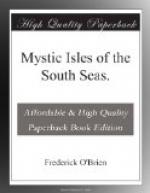The Annexe was decaying fast. In the great storm of 1906 it was partly blown down, and was poorly restored. It was the prey of rat and insect, dusty, neglected, but endearing. It had had a season of glory. It was built for the first modern administration office of the French Government, over sixty years before, and was painted white with blue trimmings. In its bare and dusty entrance-hall hung two steel engravings entitled, “The Beginning of the Civil War in the United States” and “The End of the Civil War in the United States.” The former showed Freedom in the center; Justice with a sword and balance; the Stars and Stripes being torn from a liberty-tree, with a snake winding about it; an aged man labeled Buchanan asleep on a big book; and a gentleman named Floyd counting a bag of money; on the other side Abraham Lincoln exhorted a white-haired general who commanded a file of soldiers, and some rich-looking men were throwing money on the floor.
The other picture was indeed florid. It represented three ladies, Freedom, Justice, and Mercy, disputing the center, slaves being unshackled, the army of victory led by Grant claiming honors, Lee handing over a sword, an ugly fellow toting off a bag of gold (graft?) and a gang of conspirators egging on the madman Booth to slay Lincoln. In both these engravings there were scores of supposed likenesses, but I could not identify them. They were published by Kimmel & Forster in New York in 1865, and had probably decorated Papeete walls for half a century. There were large, ramshackle chambers on the first floor, and an exquisite winding staircase, with a rosewood balustrade, led to the second story, where I lived.
In this building all the pomp and circumstance of the Nations in Tahiti had been on parade, kings and queens of the island had pleaded and submitted, admirals and ensigns had whispered love to dusky vahines, and the petty wars of Oceanic had been planned between waltzes and wines. Here Loti put his arms about his first Tahitian sweetheart, and practised that vocabulary of love he used so well in “Rarahu,” “Madame Chrysantheme,” and his other studies of the exotic woman. A hundred noted men, soldiers, and sailors, scientists and dilettanti, governors and writers, had walked or worked in those tumbling rooms.
Lovaina had owned the building many years, buying it from the thrifty French Government.
My apartment was of two rooms, and my section of the balcony was cut off by a door, giving privacy unusual in Tahiti. The coloring of the wall was rich in hue.
Any color, so it’s red, said a satirist, who might have been characterizing my rooms. Turkey-red muslin with a large, white diamond figure was pasted on the plaster walls and hung in the doorways.




